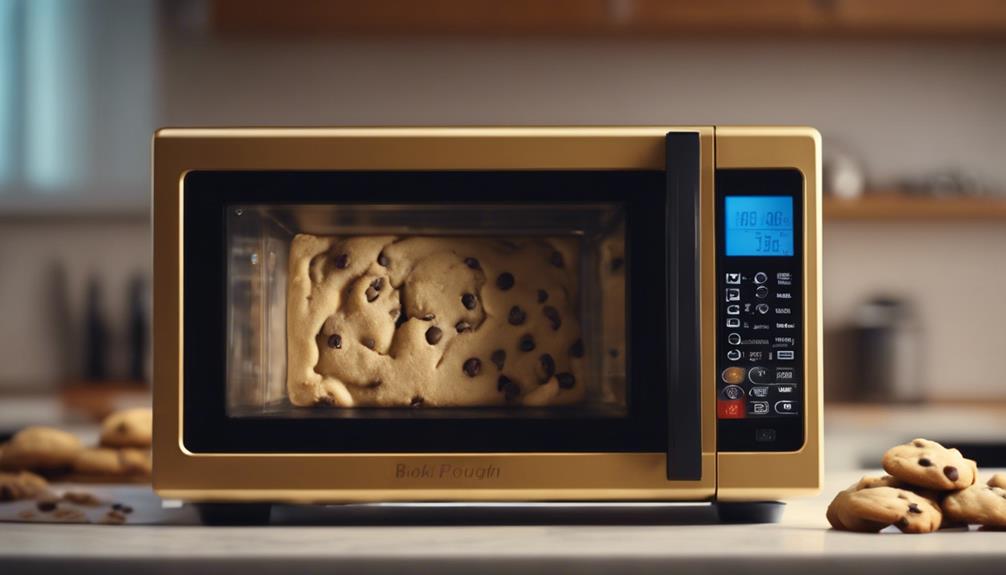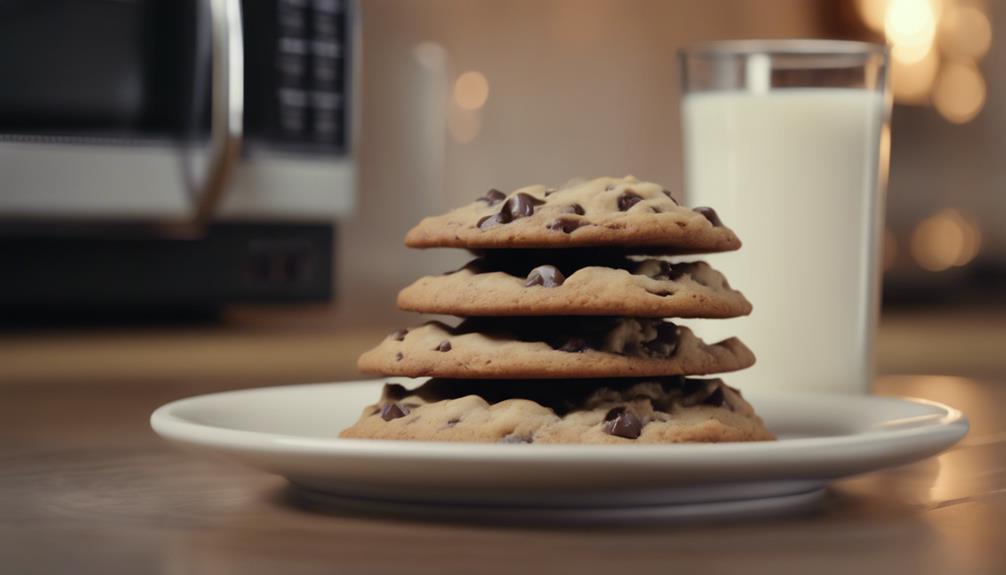Can You Make Cookies in the Microwave
Yes, you can make cookies in the microwave. While it may not produce the same texture and browning as traditional oven-baked cookies, microwaving can still yield tasty results. The key is to use a microwave-safe baking dish or plate, and adjust the cooking time and power level accordingly.
Keep in mind that the texture may be softer and the cookies may not spread or have a crispy exterior. It's a convenient option for those in a hurry or without access to an oven, but for the best cookie experience, using a conventional oven is still recommended.
Key Takeaways
- Choose microwave-safe container wisely for successful cookie making
- Optimal power level and time selection crucial for perfect cookie texture
- Monitor cooking process closely to prevent overcooking and ensure ideal doneness
- Test cookie doneness by assessing edges and center texture for perfect consistency
Cookie Ingredients and Preparation
When preparing microwave cookies, it is essential to gather ingredients such as butter, brown sugar, milk, flour, and baking soda to ensure a delightful and efficient baking process. In microwave recipes, it is common to skip using eggs.
Begin by combining the dry ingredients like flour, baking soda, and salt before folding in chocolate chips. Shape the dough into balls, press them down, and add more chocolate chips on top before microwaving.
Ensure to microwave the cookie for one minute initially and adjust based on the microwave's power to achieve the desired softness. Finally, let the cookie cool slightly before indulging in warm and gooey chocolate chip cookies straight from the microwave.
Choosing the Right Microwave-safe Container
When making cookies in the microwave, selecting the right microwave-safe container is crucial for successful results.
The container's size can impact how the cookies cook, while the material of the container can affect the cooking time.
It's important to consider these factors to ensure your cookies turn out just right.
Container Size Matters
Choosing the appropriate microwave-safe container size is crucial when making cookies in the microwave to ensure optimal cooking results. The container should be large enough to allow the cookie to spread while cooking, but not too deep to prevent it from becoming too thick. Avoid using metal containers or those with metallic accents to prevent sparks in the microwave. Opting for a round or oval-shaped container can help the cookie cook evenly. Always make sure the container is labeled as microwave-safe to avoid any safety hazards.
| Size | Shape | Material | Safety Label |
|---|---|---|---|
| Large enough | Round or oval | Microwave-safe | Checked |
Material Affects Cooking Time
The type of material used in a microwave-safe container significantly influences the cooking time required for preparing cookies in the microwave. Material comparisons reveal that glass or ceramic containers often necessitate longer cooking times compared to plastic containers.
The choice of microwave container types can directly impact cooking results and performance. Containers that promote even cooking help prevent hot spots and ensure consistent results.
It is essential to consider heat retention in containers, as thicker materials may retain more heat, potentially leading to continued cooking even after the microwave is turned off.
To enhance cooking efficiency, experiment with different containers to determine the optimal cooking time for your microwave cookie recipe.
Setting the Correct Power Level and Time

To ensure optimal cookie consistency and avoid overcooking, selecting a medium power setting of 50-70% is recommended when microwaving cookies. Starting with a cooking time of 1 minute and adjusting based on your microwave's wattage and desired doneness is crucial. Experimenting with different power levels and times can help achieve the perfect cookie texture. Here is a table summarizing the key points for setting the correct power level and time:
| Power Level | Cooking Time | Result |
|---|---|---|
| 50% | 1 minute | Soft and slightly undercooked for gooey texture |
| 60% | 45 seconds | Chewy with a slight crisp |
| 70% | 30 seconds | Crispier edges with a soft center |
Monitoring the Cooking Process
During the microwaving process, vigilantly observe the cookie's progress to ensure optimal doneness. Check the cookie after 45 seconds to avoid overcooking and look for it to rise and spread slightly. The edges should be set, but the center should remain soft.
Monitoring the baking time is crucial to prevent under or overcooked cookies. If the cookie appears undercooked, continue microwaving in 10-second intervals until done. Pay attention to the cookie's appearance; it should have a slightly golden hue when finished.
Using a microwave-safe plate helps in achieving even cooking throughout the cookie. Texture testing will also indicate if the cookie is ready to be enjoyed.
Testing for Doneness and Texture

When determining the readiness of a microwaved cookie, focus on assessing the firmness of its edges and the desired gooeyness of its center. Texture testing is crucial in achieving the perfect cookie consistency. Look for visual cues like set edges and a slightly soft center to indicate doneness. A soft center is a good indicator that the cookie is ready. Overcooking should be avoided to prevent a hard and dry texture. Consistent results can be achieved through proper monitoring and understanding of microwave baking. To ensure the cookie has the right texture, gently press on the top to feel for softness. The table below summarizes key points for testing doneness and texture:
| Keywords | Description | Importance |
|---|---|---|
| Texture testing | Assess the cookie's consistency | Essential |
| Doneness indicators | Check for soft center | Important |
| Visual cues | Look for set edges | Helpful |
| Consistent results | Avoid overcooking | Crucial |
Cooling and Enjoying Your Microwave Cookies
Once the microwave cookies have finished cooking, allow them to cool for around 5 minutes to prevent any burns.
As they cool, the cookies will continue to set, so be cautious not to overcook them initially.
For a delightful treat, consider serving the warm cookies alongside a scoop of your preferred ice cream.
Quick Cooling Methods
Utilizing efficient cooling techniques is essential for ensuring optimal enjoyment of your freshly microwaved cookies. To expedite the cooling process and preserve the cookies' crispy edges, soft centers, and chewy texture, consider the following quick cooling methods:
- Transfer the cookies to a wire rack to promote air circulation around them.
- Place the cookies in the refrigerator for a few minutes to hasten the cooling and setting process.
- For a rapid cooling method, briefly store the cookies in the freezer.
- Avoid stacking warm cookies to prevent them from becoming soggy during cooling.
Serving Suggestions
For an indulgent experience with your freshly microwaved cookies, consider enhancing their warm and gooey goodness with simple yet delightful serving suggestions. Let the microwaved cookies cool for 5 minutes before enjoying to prevent burns and allow them to set, ensuring a perfect texture.
Pairing your cookies with a scoop of ice cream creates a delicious treat, combining the warmth of the cookies with the cold creaminess of the ice cream. To elevate your cookie experience, experiment with tasty toppings like chocolate chips, nuts, or sprinkles. Get creative with combinations such as sandwiching a layer of creamy peanut butter between two cookies or adding a flavorful filling of caramel or marshmallow.
Enjoy these quick and satisfying desserts for late-night cravings or as a convenient snack during busy days.
Tips for Perfecting Your Microwave Cookie Recipe

To enhance the texture and flavor of your microwave cookies, consider incorporating a blend of butter, brown sugar, milk, flour, and baking soda into your dough mixture.
When perfecting your microwave cookie recipe, keep in mind the following tips:
- Flavor combinations: Experiment with different flavorings like vanilla extract, almond extract, or spices such as cinnamon or nutmeg to enhance the taste of your cookies.
- Texture preferences: Adjust the cooking time to achieve your desired texture, whether you prefer a softer, gooier cookie or a firmer, chewier one.
- Ingredient substitutions: Feel free to swap ingredients like using margarine instead of butter, or almond milk instead of regular milk, to cater to dietary restrictions or personal preferences.
- Personalization: Add mix-ins like nuts, dried fruit, or candies to customize your microwave cookies to suit your taste preferences.
Exploring Different Cookie Variations
Exploring a variety of cookie variations can elevate your baking experience by introducing new flavors and textures to your repertoire.
For flavor experimentation, consider adding nuts, dried fruits, or coconut flakes to the cookie dough. To enhance the taste, try unique chocolate combinations such as white chocolate, dark chocolate, or caramel-filled chocolates. Aromatic spice blends like cinnamon, nutmeg, or cardamom can bring warm and fragrant notes to your cookies.
For healthier options, substitute some butter with mashed bananas, applesauce, or nut butter to reduce fat content. Additionally, alternative flour options like almond flour, coconut flour, or gluten-free all-purpose flour can cater to gluten-free or vegan preferences.
Experimenting with these variations will allow you to create a diverse range of delicious cookies.
Frequently Asked Questions
Can I Use a Metal Container to Microwave Cookies?
When considering metal safety for microwave cookies, avoid using metal containers to prevent sparks and damage. Opt for microwave-safe alternatives like ceramic, glass, or paper plates for quick and safe cookie baking in the microwave.
How Do I Adjust the Cooking Time if My Microwave Doesn't Have Specific Power Levels?
When adjusting cooking time in microwaves without specific power levels, start with shorter intervals, like 10 seconds, to prevent overcooking. Monitor the cookie closely to achieve desired texture. Experiment with timings to find the perfect balance for soft, gooey cookies without sacrificing flavor or texture.
Can I Add Nuts or Other Mix-Ins to My Microwave Cookie Dough?
Adding fruit, chocolate chips, or candies can enhance microwave cookies. Experiment with various nut options for a crunchy twist. Get creative by trying savory additions like bacon or cheese in your microwave cookie dough to customize flavors and textures.
Can I Make Multiple Batches of Cookies in the Microwave at Once?
When considering batch size and timing in microwave cookie making, it is advisable to focus on efficiency. Using microwave-safe pans and employing even cooking techniques are crucial for consistent results when attempting multiple batches simultaneously.
Can I Store Leftover Microwave Cookies and Reheat Them Later?
When it comes to storing leftover microwave cookies, ensure freshness by placing them in an airtight container with a piece of bread to absorb moisture. Reheat them for 10-15 seconds to restore warmth and gooey texture, avoiding overheating to retain their delicious flavor.
Conclusion
In conclusion, making cookies in the microwave is a convenient and quick way to satisfy your sweet tooth cravings.
By following the proper steps and techniques, you can enjoy warm and gooey cookies in just a matter of minutes.
So next time you're in need of a delicious treat, remember that the microwave can be your secret weapon for creating tasty desserts in a flash.
